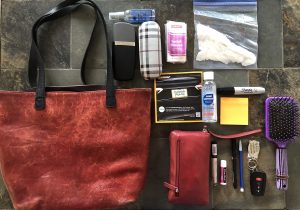

Our first assignment asks us to consider the items we carry around in a bag. This photo includes the typical contents of my purse, with the exception of my iPhone, which I needed to use to take the photo. During the current pandemic lockdown, I don’t actually take this purse many places at all. However, I do use some of its contents on a regular basis.
The bag itself was made in Italy. It holds a special place in my heart because my Mom purchased it for me during a trip she took to Italy in 2010. I have used it every day since, as shown in the scratching and fading on the well-worn leather.
The wallet is swollen with its contents that include 25 cards for various purposes, with only one being used on a regular basis: my debit card. While my debit card is the card that is used most frequently, it rarely leaves my wallet. This is because I utilize Pre-Authorized Payment technology and provide my banking information online for weekly services such as Instacart’s grocery delivery. This uses technology that protects the privacy of my personal information. My online grocery services utilizes software that allows me to select store items that I’d like to purchase. Instacart has a digital catalog that includes “over half a billion item listings from over 300 different retailers, from nearly 20,000 stores across North America” (McCreight, 2019.) To ensure accurate, real-time data, “Instacart updates more catalog data points every night than the world tweets in a day” (McCreight, 2019.) The company collects details of store-specific attributes, such as availability and pricing, and product-specific attributes, such as approved photos and nutritional information. Instacart connects with my bank account, first withdrawing funds in accordance with the order I have entered. In the event that all items are not available, it deposits the corresponding funds back into my account. It also communicates with independent shoppers who can choose whether or not to accept the opportunity of being paid by Instacart by shopping on my behalf. The Instacart platform then allows me to communicate directly with my shopper, via my mobile or desktop computer. It also alerts me when my shopper has started and finished shopping, and uses GPS technology to show me the location of my shopper when they are on their way to delivering my order to my home. Finally, my Instacart shopper uploads a photo of their delivery on my front porch to confirm its arrival.
Also of technological relevance is my choice of bank. I recently switched to a bank that doesn’t have the usual brick-and-mortar branches. Without the technology of online banking, the concept of a branchless bank would not be possible.
There are personal care items including a comb and brush, lip balm and lip gloss. The hairbrush has an elastic around it so that I can be sure to have a way to put my hair up, usually for working out or getting a massage. The lip balm and lip gloss are reflective of our pandemic times. Normally, I would have at least 5 different shades of lipstick in my purse as well. But with our current mask-wearing mandate, a little lip balm or gloss is all that is needed, with a purpose that is now purely functional rather than aesthetic.
Before this assignment, I hadn’t noticed the barcode on my lip gloss. For fun, I installed a free barcode scanning app on my phone to see what the gloss’ code would reveal. Unfortunately, its code was deemed “unreadable” by the app, so I quickly deleted the app to avoid being charged an annual fee once the app’s 3-day free trial expired. If I hadn’t done that, technology I’ve willingly enabled would withdraw funds to cover the app’s fee.
My “old school” text technology is found in the 3 writing utensils that are consistently in my bag: a black felt-tip pen, a mechanical pencil and a black Sharpie marker. I am very particular about my choice of pen, and I prefer to handwrite rather than type when doing reflective or creative work, or when I want to add a personal touch to something. I love the feeling of flow that is facilitated by these tools. It feels as though they provide an unencumbered conduit for self-expression. Most recently, my favourite pens have come from Japan via Amazon; you’ll note Japanese characters on the pen in the photo. These would have been printed on the barrel of the pens using digital printing technology. If you are curious about the full manufacturing process, this brief video describes how pens are made:
Amazon uses Amazon Web Services (AWS) cloud technology to allow buyers and sellers to access to global markets. Its cloud computing platform “…includes a mixture of infrastructure as a service (IaaS), platform as service (PaaS) and packaged software as a service (SaaS) offerings” (Rouse, 2020.)
I appreciate the sense of possibility I feel at the pairing of a Sharpie marker and Post-It notes. I carry these with me as I am always game for an impromptu round of brainstorming that can then be organized and visualized while fixed on a nearby surface. I am grateful for the failed technology (glue) that led to the versatility of Post-It notes! The process of brainstorming and arranging Post-It notes is the closest my brain comes to the “thinking and pruning” inherent in the etymology of the word “computer,” as shared by “The Word Guy,” UBC professor Jonathan Berkowitz, on CBC’s “North by Northwest” radio program.
When I want my writing to be uncensored, or when I am simply unsure of content, pencil is my writing technology of choice. I aspire to use pen to make an indelible mark with my uncertain and unfiltered thoughts one day, but for now, I prefer having an eraser as an exit plan.
The key fob for my vehicle remains in my purse at all times, as my vehicle’s keyless push button start uses a short-range radio transmitter. Beyond the fob, I am also able to lock and unlock the doors and start the engine using an app on my phone. This also uses radio technology. The keychain on my fob includes the phone number I can call for roadside assistance and the website for the dealership from which I purchased the vehicle. These details might have been printed onto the metal keychain using a 3D printing process called “binder jetting.” For more information on this process, please go to: https://www.manubim.com/3d-printing-technologies
A recent Subway coupon is included among the current contents of my purse. This coupon is indicative of the service modifications necessitated by the pandemic, as it features curbside pick-up through the use of the Subway App. The coupon utilized printed QR (or “Quick Response) code technology that allowed me to scan the code and be taken directly to the App Store on my iPhone, where I could download the app. This app will allow me to pre-order and pay for my Subway purchases and pick them up via curbside service.
The hand sanitizer and Ziploc bag of disinfecting wipes are a sign of the COVID times. While I had hand sanitizer in my bag prior to the pandemic, the bottle was much smaller as it wasn’t used as frequently. A travel-size package of tissue is also a mainstay of my purse contents. I certainly did not see a relationship between my Kleenex and text before this course. It was interesting to learn that the word text was derived from tissue, and I like to think of works of text as a weaving of words.
The final items in my bag help me to see the world more clearly. I always have 2 eyeglass cases; one for my prescription sunglasses and one for my eyeglasses. I also carry a bottle of eyeglass cleaner. Scanning technology is used to download my prescription details at the beginning of the manufacturing process. The measurements for my prescription are then programmed into a tray that holds disks that will ultimately be placed within my chosen eyeglass frames.
Reviewing the contents of my purse, I can see that my digital literacies afford numerous conveniences in my life, and that many of these functions are invisible on the surface. No one could possibly glean all of the insights described here by simply viewing the contents. The contents don’t offer as much insight as they might during non-pandemic times. The purse would include additional items if I were to be away from home for 8-10 hours a day, which was typical of pre-pandemic life. It would include a water bottle, some snacks and some artifacts of relevance for errands to be run or outings to be enjoyed.
Although the purse is lighter in content than usual, I think it reflects aspects of my “authentic self.” While I appreciate the obvious risk involved, the zippered openings of my purse are always open. I think this reflects my open-mindedness as well as my desire for instant access to the things that I need. Others may view this as risky and disorganized, which may also characterize me on a “bad day.” My purse content also reflects my attention to aesthetics, with a wallet that was carefully chosen to match the purse.
If I imagine what this bag might have looked like 15 or 25 years ago, it would’ve taken the form of a backpack where I had even more possessions with me on a given day. As I lived in rural area, I spent even more time away from home, and I tried (and often failed) to keep things simple by putting everything – work files, lunch, gym clothes, laptop – in one bag. As noted earlier, many of my purse’s contents are reflective of this current context of COVID. It will be interesting to see how it evolves when/if life returns to “normal.”
References:
McCreight, G. (2019, May 8). The Story Behind an Instacart Order, Part 1: Building a Digital Catalog. Medium. https://tech.instacart.com/the-story-behind-an-instacart-order-part-1-building-a-digital-catalog-46df5a8ff705
Rouse, M. (2020, April). Amazon Web Services (AWS). Tech Target Network. https://searchaws.techtarget.com/definition/Amazon-Web-Services